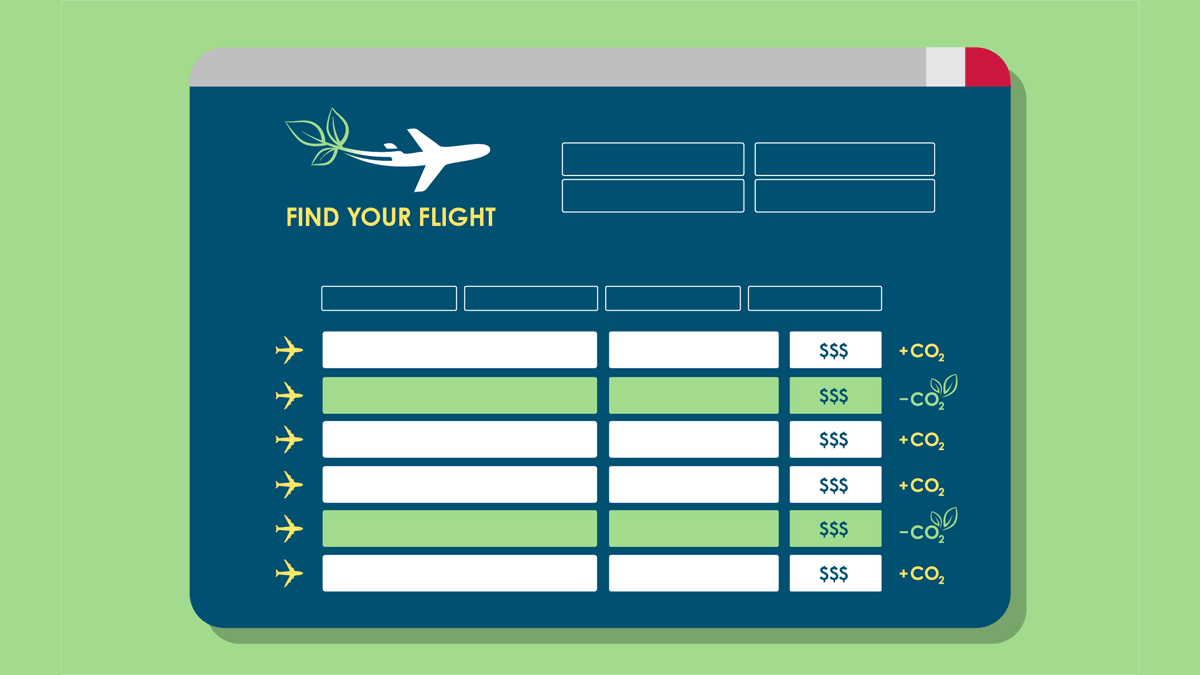How Providing Emissions Information Can Begin Greening Aviation
Those carefree, pre-pandemic days of hopping on a flight for a meeting or vacation without a second thought may seem like a distant memory to some of us right now. Still, air travel this fall has far exceeded that of 2020, even if it has yet to recover to pre-pandemic levels. Fairly soon, flying will almost certainly return to the upward trend that showed global air travel more than doubled from 2004-2019.
That’s a problem for the climate.
Flights accounted for about 2.5% of worldwide greenhouse gas emissions in 2019. While the federal government has announced an emissions reduction target of 20% by 2030 and a key airline industry group has recently proposed a net-zero plan, there is no firm consensus on a path to decarbonization for the aviation sector.
Can individual travelers play a role in reducing emissions?
Many climate hawks are cutting back or choosing not to fly at all. And it turns out that even when we do fly, our choices matter–different flight itineraries on the same route can vary quite a bit in the amount of greenhouse gases they generate, primarily due to the number of layovers (take-offs and landings produce a lot of emissions), the locations of the layovers, and the fuel efficiency of the aircraft. For example, a traveler heading from Sacramento, CA to Washington, DC might see a selection of flights that vary in emissions by as much as 30%.
That’s why the new emissions information you see when searching on Google Flights is so important. Our research indicates that people will use this information to choose lower-emissions flights.

How Emissions Information Can Make a Difference
In 2015 we began work on GreenFLY.ucdavis.edu, a demo flight search website that shows the emissions of each flight as prominently as the price, labels the lowest emissions options “Your GreenFLY,” and, by default, sorts flights from lowest to highest emissions. Experimenting with GreenFLY helped us demonstrate the wide variation in emissions among flights with the same origins and destinations, especially for long cross-country or international flights.
We conducted two experiments to test whether this method of providing emissions information on available flight options would nudge travelers toward choosing lower-emitting flights. After all, someone using a flight-search website is already balancing many factors, such as when to fly, price, length of layover and perhaps a favorite airline; why not put emissions into the mix? In our studies we asked people to choose between a few flights, and we used that data to build a predictive model of how much value people put on different factors such as price, layovers, and emissions.
As most other researchers into flight choice have found, price was the most important consideration. But we also found that people were willing to pay more for a lower-emissions flight. For instance, an international flight might emit around a metric ton of carbon (1000kg); and people were willing to pay $20 more for a ticket that avoided 100kg of CO2 emissions, or about 10%. This translates to a rate (“willingness to pay”) of about $200/ton of CO2 saved, much higher than the average price of carbon offsets, which is about $3-6/ton! This surprisingly strong effect was consistent between two studies looking at different populations (one of UC Davis employees and one of more broadly recruited American travelers).
Real-World Emissions Reductions
Our studies presented travelers with hypothetical trips, and our GreenFLY site was just a demo. But now that Google Flights is using an emissions-focused interface, we will have an opportunity to see how emissions information will influence consumer behavior on a huge scale. We’re optimistic that we’ll see an impact on the travel choices of Google Flights’ many users and, possibly, on overall aviation emissions.
The possibilities are exciting. If more travel booking and search platforms follow the lead of Google and others like Kayak, Skyscanner, and Lite Flights, this could have a cascading effect. Many consumers choosing lower-carbon flights could push airlines to invest in more fuel-efficient aircraft as well as sustainable aviation fuels. Repeatedly seeing emissions information could raise traveler’s awareness of the environmental cost of flying. This may ultimately build support for emissions reduction regulations and investments in more sustainable travel alternatives.
###
More information on the authors’ GreenFLY research is available in an NCST Report, NCST Policy Brief, a 2021 Transportation Research Record paper, and a 2017 Design, User Experience, and Usability Conference Paper.
—
Angela Sanguinetti is a Research Environmental Psychologist at the UC Davis Institute of Transportation Studies and Energy & Efficiency Institute.
Nina Amenta is professor of Computer Science at UC Davis.
Mike Sintetos is Policy Director for the National Center for Sustainable Transportation (NCST) and SB1 Research Program at the UC Davis Institute of Transportation Studies.
Thank you for your interest in the UC Davis Institute of Transportation Studies. Subscribe today to keep up with the latest ITS news and happenings.
